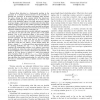Free Online Productivity Tools
i2Speak
i2Symbol
i2OCR
iTex2Img
iWeb2Print
iWeb2Shot
i2Type
iPdf2Split
iPdf2Merge
i2Bopomofo
i2Arabic
i2Style
i2Image
i2PDF
iLatex2Rtf
Sci2ools
119
Voted
INFOCOM
2008
IEEE
2008
IEEE
Feasible Rate Allocation in Wireless Networks
—Rate allocation is a fundamental problem in the operation of a wireless network because of the necessity to schedule the operation of mutually interfering links between the nodes. Among the many reasons behind the importance of efficiently determining the membership of an arbitrary rate vector in the feasibility region, is its high relevance in optimal cross layer design. A key feature in a wireless network is that links without common nodes can also conflict (secondary interference constraints). While the node exclusive model problem has efficient algorithms [7], it has long been known that this is a hard problem with these additional secondary constraints [1]. However, wireless networks are usually deployed in geographic areas that do not span the most general class of all graphs possible. This is the underlying theme of this paper, where we provide algorithms for two restricted instances of wireless network topologies. The first tractable instance considers nodes placed arbit...
Related Content
| Added | 31 May 2010 |
| Updated | 31 May 2010 |
| Type | Conference |
| Year | 2008 |
| Where | INFOCOM |
| Authors | Ramakrishna Gummadi, Kyomin Jung, Devavrat Shah, Ramavarapu Sreenivas |
Comments (0)

